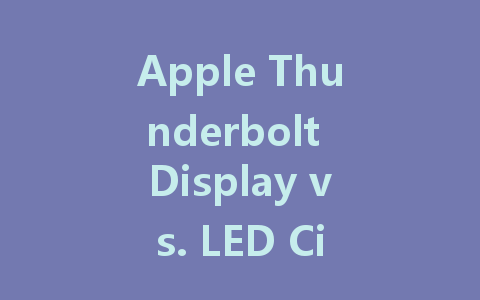
When it comes to high-quality displays for Mac users, two options often stand out: the Apple Thunderbolt Display and the LED Cinema Display. Both monitors have their unique features and benefits, but which one is the better option for you? In this article, we will look at the key differences between these two displays, examine their specifications, and help you make an informed decision based on your specific needs.
Overview of the Displays
Apple Thunderbolt Display
Released in 2011, the Apple Thunderbolt Display was Apple’s first model to integrate Thunderbolt technology. This monitor offered a stunning 27-inch display with a resolution of 2560 x 1440 pixels. Its sleek design was complemented by built-in features like a FaceTime HD camera, an array of USB ports, and an integrated MagSafe charger for compatible MacBooks.
LED Cinema Display
On the other hand, the LED Cinema Display, which first appeared in 2009, was designed to be a high-end monitor primarily for creative professionals. Similar in size to the Thunderbolt Display, the LED Cinema Display features a 27-inch screen with a resolution of 2560 x 1440 pixels. However, it is known for its IPS panel, providing superior color accuracy and wider viewing angles, featuring two USB 2.0 ports and a built-in iSight camera.
Design and Build Quality
When it comes to design, both displays retain the signature Apple aesthetic. However, there are subtle differences between the two.
Thunderbolt Display Design
The Thunderbolt Display features a thicker bezel and a more robust build, alongside a more extensive array of ports, including Thunderbolt, FireWire, and Ethernet, making it more versatile for connectivity. This model’s design allows for better cable management with its integrated cable solution.
LED Cinema Display Design
In comparison, the LED Cinema Display’s design is slightly sleeker and more minimalistic. It also has an aluminum casing, which aligns with Apple’s premium product offering. Its aesthetic appeal makes it a favorite for professionals looking for a sophisticated appearance in their workspace.
Connectivity Options
Thunderbolt Connectivity
One of the most significant advantages of the Apple Thunderbolt Display is its Thunderbolt connectivity. Thunderbolt allows for high-speed data transfer and can drive multiple displays from a single port. Through Thunderbolt, you can daisy-chain devices, which is especially advantageous for professionals who work with multiple peripherals.
Cinema Display Connectivity
The LED Cinema Display uses Mini DisplayPort for video input, which, while still capable, is not as versatile as Thunderbolt. It features USB 2.0 ports that are useful but not as fast as USB 3.0 or Thunderbolt connections. If you are using the LED Cinema Display with older Mac models or devices, this may limit your overall performance.
Performance and Image Quality
Thunderbolt Display Performance
Both displays offer exceptional performance, but the Thunderbolt Display has a slight edge due to its advanced technology. It boasts brighter colors and better color reproduction, which is ideal for graphic designers and video editors. Its performance under varying lighting conditions is slightly better thanks to its higher luminance and contrast.
Cinema Display Performance
The LED Cinema Display, while still high quality, may not compare in terms of brightness. However, its IPS panel provides excellent color accuracy and wide viewing angles, making it a fantastic option for visual content creators needing precise colors.
Price Consideration
Price is an essential factor when deciding between these two displays. The Thunderbolt Display is typically more expensive due to its advanced connectivity features and greater versatility. If budget is a concern, the LED Cinema Display can be found at a lower price point and still offers impressive quality.
Conclusion: Which Display Should You Choose?
Choosing between the Apple Thunderbolt Display and the LED Cinema Display ultimately depends on your specific needs and usage scenario.
No matter which display you choose, both options deliver the quality and performance that Apple is known for, enhancing your workspace productivity and enjoyment.